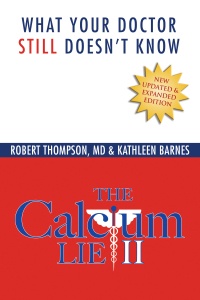 by Robert Thompson, M.D.
by Robert Thompson, M.D.
(my co-author on The Calcium Lie 2: What Your Doctor Still Doesn’t Know)
Testosterone replacement is becoming an increasingly controversial subject, with good reason.
Time Magazine in it’s Aug. 18, 2014 edition, published a cover story on the big business aspects of the testosterone replacement industry entitled, “Feeling Deflated? The Low-T Industry Wants to Pump You Up.”
Seriously, there are now medical clinics dressed up as man caves with sports memorabilia and lounge-like waiting rooms complete with complementary wine and beer to get men to come in.
This is big business, $2.4 billion in 2013. Almost all of this is being done for money, completely irresponsibly and completely wrongly. This is why I often say the practice of medicine is no longer a profession; it is big, irresponsible for-profit business.
Are there reasons for low T? Yes, too many for this discussion, but there is one primary reason that affects everybody:
Chemicals and compounds that act like estrogen and suppress natural testosterone production are getting into men’s bodies through food and water.
The symptoms and metabolic effects of low T are profound, including but not limited to the following:
- Diminished sex drive
- Fewer spontaneous erections
- Decreased erectile tension and longer recovery time
- Decreased intensity of orgasm
- Depression
- Reduced muscle mass and strength
- Lowered metabolic rate
- Decreased sperm count
- Hair loss
- Enlarged or painful breast tissue
- Muscle aches and pains
- Irritability
- Mood changes
- Fatigue
- Not to speak of the proven increased disease risks including diabetes, metabolic syndrome, heart disease, osteoporosis and cancer (especially prostate)
So why is there confusion? Basically, because doctors are not being taught how to replace testosterone safely and most men have no idea of these incontrovertible facts:
- A certain proportion of testosterone is converted to estrogen in men by a naturally occurring enzyme called aromatase. This conversion rate increases as men age and with obesity. It contributes to breast enlargement and in some cases, breast tenderness. This conversion of testosterone to estrogen is responsible for almost all complications of testosterone therapy, especially blood clots, precipitating potentially heart attack, stroke, pulmonary embolus and other blood clotting vascular disorders.I find estrogen levels are rarely checked by physicians who think they know how to prescribe testosterone. Estrogen should always be kept at less than 30 (normal in men is about 10-40, depending on the laboratory). Some men will have high estrogen levels before therapy is begun. I now try to suppress estrogen levels in these patients before starting testosterone therapy. If they do not suppress estrogen levels to low normal, I do not treat them with testosterone.The medication I use to do this is called Anastrazole. It has been used for years in men with prostate cancer to help suppress estrogen which can also cause the prostate to grow larger (benign prostatic hypertrophy–BPH) and can stimulate prostate cancer to grow. It is now generically available and fairly inexpensive at the doses we use. The dose used with testosterone replacement is typically much lower than those that are used in prostate cancer patients, typically 0.25mg (1/4th tablet) every other day, some men every three days and some daily.
There can be no exceptions to the rule that estrogen levels must be kept below 30. - Testosterone has the ability to increase red blood cell production. This is more likely with injection therapy, probably due to the large peaks in the testosterone levels soon after the injection. This is why testosterone use is prohibited in athletes trying to increase red blood cells to increase performance. If the blood hematocrit gets over 54% (too thick) significant increased risk of blood clot and stroke can occur. Testosterone must be stopped and blood must be drawn off.This therapy does however help create wonderful blood donors who are literally red blood cell factories!I require all my patients being treated with testosterone to have CBC at least every six months, even after correct testosterone levels and estrogen levels at a certain replacement dose have been achieved repeatedly six months apart and no longer need to be checked.If the patient becomes a regular blood donor, the blood bank will automatically check the hematocrit and this makes further blood testing unnecessary provided the donor card is received by my office and documented in the medical chart.
Donating blood is one of the best ways to get toxins out of your body, so it is very beneficial health wise. More importantly, it saves lives.
How to safely replace testosterone
Injections: I have some patients who are still on injections. If they wish to remain on injections, I recommend two shots per week to try to minimize the peaks and troughs of the blood testosterone levels. In general, it is much more difficult to get to optimal levels with intramuscular injections due to gradual accumulation of the depo-testosterone in oil levels in the tissue. But once these levels are repeatedly in the 550-850 range, I am happy with the dosage level being given. I will check levels at least monthly at first to be sure the dosage level is appropriate. Doses are typically about 40-50 mg two times per week.
Use only use the bio-identical version, not the anabolic steroid version of the hormone.
Trans Muscoosal Therapy (TMRx): This means an oral dosage daily as a troche, not being swallowed, but by being absorbed sub-lingually (under the tongue).
Or my preference and that of most of my patients, and the cheapest and easiest way to get perfect levels daily, trans-mucosally, is rectally. I, too, thought this was a bit weird until I tried it. After over two years of injections, I was truly amazed and pleased at how easy it was and no more needles, yay!
It was so quick and easy and so inexpensive, that I began encouraging my patients to try it. Most seem to prefer it because of the cost — typically about $20-30 per month for the generic, unpatentable testosterone hormone compounded by my local pharmacy. We use tiny 0.5ml syringes (no needles) and get amazing results. Once the correct dose levels are known, blood test levels are often almost identical six months apart, with rare exceptions.
We also often add DHEA to the testosterone replacement cream. Doses are typically about 20mg testosterone daily (range 16-40 mg) and if DHEA is added, this is about 2.5mg daily (range 2.5 to 5mg)
I think transmucosal therapy is best for four major reasons:
- The peak dose in the blood stream occurs 30 seconds after application.
- It achieves predictable and repeatable blood levels)
- It’s cheaper (about $300 per year for the rectal, about $600 per year for troches)
- It’s safer. It doesn’t rub off on others or clothing, potentially harming the women in our lives.
This is not big business; it is good, compassionate medicine.






